WW1 Military Watches: Difference between revisions
| (14 intermediate revisions by 3 users not shown) | |||
| Line 39: | Line 39: | ||
=====Nomenclature to the dial===== | =====Nomenclature to the dial===== | ||
---- | ---- | ||
The dials carried as a minimum the name of the supplier and the specification that the watch was intended to meet (eg Mark IVA). | The dials of British WWI aviation watches carried as a minimum the name of the supplier and the specification that the watch was intended to meet (eg Mark II, Mark IVA). This applied whether the watches were issued by the War Office or the Admiralty. | ||
War Office items carried individual serial numbers applied to the dial, followed by a letter code that identified the supplier. It was standard practice during WWI to mark military equipment supplied under contract in this way. It allowed each individual item to be referenced in a contract ledger, giving details of the size of the order, the series number range allocated to each order, the item to be delivered, the name of the contracted supplier, the contract reference number, and dates. | |||
Whilst the suppliers of Mark IVA watches were required to apply a serial number followed by a letter code to each dial, the Swiss manufacturers of Mark V watches applied their assigned (digraphic) letter code to the dial, followed by the item’s serial number. Company branding was allowed to appear on Mark V watches only to interior surfaces, eg the movement, cuvette, inner case back, etc. | |||
---- | ---- | ||
===== Luminous and non-luminous versions ===== | ===== Luminous and non-luminous versions ===== | ||
---- | ---- | ||
| Line 61: | Line 62: | ||
*'''A ↑ S case back mark (''sui generis'', possibly not an official ‘mark’)''' | *'''A ↑ S case back mark (''sui generis'', possibly not an official ‘mark’)''' | ||
:An | :An A ↑ S mark appears only on one watch: a Mark IVA supplied by S. Alexander & Son Ltd. The mark may simply be supplier's branding (A & S) rather than a service designator. ZMW [p 12] attributes this mark to the Royal Naval Air Service c. 1914 (‘Air Service’), but the RNAS would have been equipped with the Admiralty’s own Mark I and Mark II watches rather than the Mark IVA. ‘Airship Service’ has also been suggested but is doubted for the same reason: all airships were surrendered to the control of the Admiralty during WWI. | ||
*''' | *'''W ↑ D case back (War Department) (up to 1917)''' | ||
:The | :The War Department (W.D.) mark was applied to the Mark IVA watch until the marking was cancelled in 1917. (The mark typically appears to the case back, although an early issue of the Mark IVA watch supplied by G Davenport & Co Ltd sees the mark painted to the dial; the putative Mark III watch also sees the mark painted to the dial). At least three different designs of the W.D. mark were employed: (i) an elaborate decorated version that occupied the whole of the flat portion of the case back; (ii) a boldly-engraved, simple, style, that is perhaps confined to early issue watches; and (iii) a much smaller, simple, stamped version, that is the more common usage seen in surviving examples. | ||
:Although the War Department became the War Office in 1857, the name remained in use for certain purposes. | |||
*'''A [underline] ↑ case back and dial mark (possibly Air Board) (1917 onwards)''' | |||
:This mark was applied to all Mark V watches (and to a very late version of the Mark IVA supplied by H. Williamson Ltd c 1917). The use of this mark may reflect the creation of the Air Board in 1917 (and so represents the word ‘Air’), since it is common to all equipment issued under Air Board specifications. However, ZMW [p 12] prefers ‘Aviation’. | |||
*'''King’s Crown surmounting ‘A.M.’ case back mark (Air Ministry) (inter-war)''' | |||
: | :The Air Ministry mark, which was used from the inter-war period until c 1943, occasionally appears in addition to one of the other marks, indicating retention in stores after WWI. These watches sometimes have ‘G.S. Type’ applied to the dial, indicating a General Service watch that in RAF usage was assigned the 6E/50 stores reference. | ||
*'''Sterile case backs (no markings)''' | *'''Sterile case backs (no markings)''' | ||
:The Admiralty Mark I and Mark II had sterile case backs, apart from one version of the Mark II that was supplied by Thos. Armstrong & Bros, Manchester (which had a unique stamped ‘long arrow’ design). Presumably the nomenclature that appeared on the Mark I and Mark II watch dials was considered sufficient for most purposes | :The Admiralty Mark I and Mark II had sterile case backs, apart from one version of the Mark II that was supplied by Thos. Armstrong & Bros, Manchester (which had a unique stamped ‘long arrow’ design). Presumably the nomenclature that appeared on the Mark I and Mark II watch dials was considered sufficient for most purposes. | ||
---- | ---- | ||
=====Eight-day movements===== | =====Eight-day movements===== | ||
---- | ---- | ||
Before the 30-hour Mark V standard was formulated, the British aviation watch used a variety of Swiss 8-day movements. | Before the 30-hour Mark V standard was formulated, and the supply of watches procured directly via Swiss manufacturers, the British aviation watch used a variety of Swiss 8-day movements in watches that were supplied by a surprising array of contractors, not all of them recognised watchmakers. | ||
'''Octava Watch Company (Swiss nickel-finished 8-day movement)''' | '''Octava Watch Company (Swiss nickel-finished 8-day movement)''' | ||
---- | ---- | ||
:The Octava 8-day movement was used by various contractors to supply the Admiralty Mark I and Mark II, the (putative) Mark III, and the Mark IVA. An anomalous version of the Mark V (which otherwise is a 30-hour watch) also used the Octava 8-day movement. | :The Octava 8-day movement was used by various contractors to supply the Admiralty Mark I and Mark II, the (putative) Mark III, and the Mark IVA. An anomalous version of the Mark V (which otherwise is a 30-hour watch) also used the Octava 8-day movement. | ||
:All Octava movements have serial numbers stamped to the base plate near the balance wheel. | |||
:For a while, Georges Favre Jacot et Cie of Le Locle (better known today as [[Zenith]]) supplied a Mark IVA watch with a movement of this design marked with its own BILLODES trademark. (Later examples were marked Octava in the standard manner). | :For a while, Georges Favre Jacot et Cie of Le Locle (better known today as [[Zenith]]) supplied a Mark IVA watch with a movement of this design marked with its own BILLODES trademark. (Later examples were marked Octava in the standard manner). | ||
'''Charles Hahn and Cie (later to become Landeron) (Swiss gilt-finished 8-day movement)''' | |||
---- | |||
-- | : This Swiss-made gilt 8-day movement was used by various contractors (G Davenport & Co Ltd, Etienne & Cie, S. Smith & Sons (M.A.) Ltd, W Ehrhardt) to supply the Mark IVA watch. A very similar movement was used by Nicole, Nielsen & Co Ltd to supply the Mark IVA watch, suggesting perhaps that this company was the communal source for the movements used by other suppliers. (Nicole, Nielsen & Co Ltd had a documented commercial relationship with S. Smith & Son, supplying motor accessories as well as ebauches). | ||
: | :The movement carries serial numbers stamped visibly to a main movement plate. | ||
'''Eterna Calibre 83 (Swiss gilt-finished 8-day movement)''' | '''Eterna Calibre 83 (Swiss gilt-finished 8-day movement)''' | ||
---- | ---- | ||
:This movement was supplied uniquely by H Williamson Ltd London for the Mark IVA watch (and possibly the Admiralty Mark II). | :This movement was supplied uniquely by H Williamson Ltd London for the Mark IVA watch (and possibly the Admiralty Mark II). | ||
:Serial numbers are stamped to the base plate near the balance wheel. | |||
:The movement, attributed to Eterna, is entirely different to the 7-jewel Astral movement that Williamson used for its General Service watches supplied to the British Army during WWI. | :The movement, attributed to Eterna, is entirely different to the 7-jewel Astral movement that Williamson used for its General Service watches supplied to the British Army during WWI. | ||
'''Douard Patent (Swiss gilt-finished 8-day movement)''' | '''Douard Patent (Swiss gilt-finished 8-day movement)''' | ||
---- | ---- | ||
| Line 157: | Line 157: | ||
===='''The Admiralty Mark II '''==== | ===='''The Admiralty Mark II '''==== | ||
---- | ---- | ||
The Admiralty Mark II watch was supplied by two firms: (1) Thos. Armstrong & Bro, Manchester (using the Swiss 8-day Octava movement); and (2) S. Smith & Sons (M.A.) Ltd (using the Swiss gilt | The Admiralty Mark II watch was supplied by two firms: (1) Thos. Armstrong & Bro, Manchester (using the Swiss 8-day Octava movement); and (2) S. Smith & Sons (M.A.) Ltd (using the Swiss gilt Douard patent 8-day movement). | ||
The Admiralty Mark II appeared in both a luminous (black dial) and non-luminous (white dial) version. S. Smith & Sons (M.A.) Ltd supplied both versions. | The Admiralty Mark II appeared in both a luminous (black dial) and non-luminous (white dial) version. S. Smith & Sons (M.A.) Ltd supplied both versions. | ||
| Line 165: | Line 165: | ||
Admiralty Mark II case backs were sterile, except for the Thos. Armstrong & Bro type (b) dial, which feature a stamped, stylised ‘long arrow’ design. | Admiralty Mark II case backs were sterile, except for the Thos. Armstrong & Bro type (b) dial, which feature a stamped, stylised ‘long arrow’ design. | ||
---- | ---- | ||
===='''The Mark III '''==== | ===='''The Mark III '''==== | ||
---- | ---- | ||
| Line 195: | Line 196: | ||
Points to note: | Points to note: | ||
:*There is no system to these codes because they were assigned by the contracting authority on demand and they apply to any item or instrument supplied by | :*There is no system to these codes because they were assigned by the contracting authority on demand and they apply to any item or instrument supplied by the designated company under contract to the War Office. The gaps occur because the system applies to all contracted equipment, not simply watches. | ||
:*Williamson used the unique Eterna calibre 83 | :*In relation to the movements used in the supply of the Mark IVA watch: H Williamson used the unique Eterna calibre 83; G Davenport Co Ltd, Etienne & Cie, W Ehrhardt and S Smith & Sons (M.A.) Ltd used only the (unattributed) gilt 8-day movement (with a variant of this movement being used by Nicole, Nielsen & Co: see below); all other contracted suppliers used the Octava movement. | ||
:*Although the S monograph is assigned to Nicole, Nielsen & Co, all surviving examples are now attributed to S Smith & Sons (M.A.) Ltd. | :*Although the S monograph is assigned officially to Nicole, Nielsen & Co, all surviving examples are now attributed to S Smith & Sons (M.A.) Ltd. If, as the assigned letter code suggests, these watches were supplied originally by Nicole, Nielsen & Co, it raises the possibility that they were supplied before 1917 (and would have carried white dials); their current appearance would then have resulted from a later redial (in black) with S Smith & Sons (M.A.) Ltd nomenclature applied. This putative redial would have occurred some time after April 1917, when black dials were mandated for all Mark IVA watches. (From 1917, Nicole, Nielsen & Co became known as North & Sons and Watford Speedometers, which might explain the reassignment. The firm is known to have supplied S Smith & Son with watch movements, as well as motor accessories such as speedometers, which were rebadged). It is difficult to place these particular watches in a timeline because the movement used (a Swiss gilt 8-day movement) is unique to them and has its own numbering system, although its design is very close to that of the gilt 8-day movement used by G Davenport Co Ltd, Etienne & Cie, W Ehrhardt and S Smith & Sons (M.A.) Ltd. | ||
:*The A.G. code was also used for Mark IVA watches that have an Air Board mark applied to the dial. This mark dates the watches to late-1917 and beyond. The A.G. digraph was probably | :*The A.G. code was also used for Mark IVA watches that have an Air Board mark applied to the dial. This mark dates the watches to late-1917 and beyond. The A.G. digraph was probably chosen to complement the B.G. digraph that was assigned to the 8-day Mark V watches (which were anomalous because the Mark V issue otherwise used 30-hour movements). These Air Board-marked Mark IVA watches are often misattributed to Moise Dreyfuss, which also used the A.G. letter code, but these latter watches can be distinguished readily by their use of the W.D. mark. | ||
:*S Alexander & Son seems to have used the digraphic letter code AJ initially, to be superseded by the monographic Z code later in the war. | :*S Alexander & Son seems to have used the digraphic letter code AJ initially, to be superseded by the monographic Z code later in the war. | ||
| Line 209: | Line 210: | ||
:*The Williamson watch apart, the early supply of Mark IVA watches appears to have come from motor accessories suppliers before recognised 'watchmakers' were involved (although the term 'watchmaker' has to be used with caution, especially in discussions of English firms of this era). Similarly, the Admiralty watches were supplied by instrument makers and by S. Smith and Sons (Motor Accessories) Ltd rather than by watchmakers. | :*The Williamson watch apart, the early supply of Mark IVA watches appears to have come from motor accessories suppliers before recognised 'watchmakers' were involved (although the term 'watchmaker' has to be used with caution, especially in discussions of English firms of this era). Similarly, the Admiralty watches were supplied by instrument makers and by S. Smith and Sons (Motor Accessories) Ltd rather than by watchmakers. | ||
---- | ---- | ||
===='''The Mark V '''==== | ===='''The Mark V '''==== | ||
---- | ---- | ||
| Line 225: | Line 227: | ||
:B.H. - Record; | :B.H. - Record; | ||
:B.K. - Electa; | :B.K. - Electa; | ||
:B.L. - Paul Garnier; | :B.L. - Paul Garnier (whose post-WWI agent in the U.K. was Moise Dreyfus); | ||
:C.B. - Zenith; | :C.B. - Zenith; | ||
:C.C. - Moser. | :C.C. - Moser. | ||
| Line 238: | Line 240: | ||
---- | ---- | ||
=== '''British Watches, Pocket General Service''' === | === '''British Watches, Pocket General Service''' === | ||
---- | ---- | ||
| Line 317: | Line 320: | ||
[[file:F1345BC5-600E-4F93-A4D6-C5AB0F8AFD60.jpeg|thumb|left|H Williamson Ltd GS pocket watch c 1914 showing hunter dial arrangement]] | [[file:F1345BC5-600E-4F93-A4D6-C5AB0F8AFD60.jpeg|thumb|left|H Williamson Ltd GS pocket watch c 1914 showing hunter dial arrangement]] | ||
Many of the supplied savonette movements carry Williamson's Coventry Astral Star trademark | Many of the supplied savonette movements carry Williamson's Coventry Astral Star trademark (which dates from c 1910). The Astral was Williamson's standard 7-jewel model and was produced using machine made techniques. ZMW [p 26] describes the hunter movement as being used in Williamson’s earlier contract watches, culled from their existing stocks due to the exigencies of war. However, the watch shown in ZMW has a c 1916 issue number that probably reflects the supply crisis of the mid-war period rather than the rush to war in 1914. The two types of movement have entirely-separate serial number sequences applied to their plates, which run continuously in parallel throughout the issue. | ||
H. Williamson used nickel Cases from Dennison but also employed an American made case (the Illinois Watch Case Co). | H. Williamson used nickel Cases from Dennison but also employed an American made case (the Illinois Watch Case Co). | ||
H. Williamson also supplied watches as naval issue, with the movement serial number painted to the dial (where the issue number sits in the Army issue), and the backs being marked P ^ W. | H. Williamson also supplied these 7-jewel watches as naval issue, with the movement serial number painted to the dial (where the issue number sits in the Army issue), and the backs being marked P ^ W. On the evidence of the Report of the Astronomer Royal relating to Chronometers (May 1915 to May 1916), these appear to date from 1915/16: ‘''[a] cheaper form of watch, which has been given the name of Pocket Watch, was called for by the Admiralty during the year. Of these 600 have been purchased after being tested''’. Further purchases were recorded for the duration of WWI: 200 watches (1916-17); 280 watches (1917-18); 396 watches (1918-19). | ||
The pocket watches made by H Williamson Ltd were mostly machine-made in Coventry, with other factories operating in Birmingham and Chaux-de-Fonds (Buren). The Head Office and a branch works, however, were established in London E.C.1. The company also produced an 8-day version of the Mark IVA aviation watch using a Swiss movement that was sourced from Eterna. | The pocket watches made by H Williamson Ltd were mostly machine-made in Coventry, with other factories operating in Birmingham and Chaux-de-Fonds (Buren). The Head Office and a branch works, however, were established in London E.C.1. The company also produced an 8-day version of the Mark IVA aviation watch using a Swiss movement that was sourced from Eterna. | ||
| Line 328: | Line 331: | ||
---- | ---- | ||
==== '''Elgin (vocab letters R (G-294) and S (G-293))''' ==== | ==== '''Elgin (vocab letters R (G-294) and S (G-293))''' ==== | ||
---- | ---- | ||
Latest revision as of 12:43, 6 March 2024
Notes on British Military Watches 1914-1919
References
Books
- Konrad Knirim British Military Timepieces/Uhren der britischen Streitkräfte (POMP, 2009) (‘KK’)
- Z. M. Wesolowski A Concise Guide to Military Timepieces 1880-1990 (The Crowood Press, 1996) (‘ZMW’)
Articles
- A Taylerson Military Timepieces: Watches Issued to British Armed Forces 1870-1970 (Horological Journal September 1995 pp 293-296; October 1995 pp 334-337) (British Horological Institute,1995) (‘Taylerson’)
British Watches, Aircraft
Historical Background
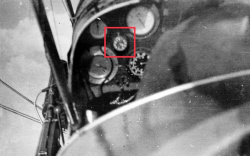
For much of the First World War, British military procurement was pursued separately by the Admiralty and the War Office. The procurement of aviation watches was no exception, although there is a clear horological connection between the watches issued by the two branches.
The watches under discussion ('aviation watches') are sometimes known as cockpit clocks but they are essentially pocket watches of no special design, apart from a pendant that was required to protrude from any housing that was used to fix them to a bulkhead in the cockpit. The watches were cased in nickel or plated steel, with the usual military markings often applied to the case back. The dials carried nomenclature that related to their supply under contract
All watches were supplied according to published specifications and each iteration of the requirement was marked accordingly. During WWI, the Admiralty issued the Mark I, followed by the Mark II, whilst the War Office (via the Royal Aircraft Factory) issued the Mark IVA. The Mark V aviation watch was issued to both services after supply chains had merged during 1917. (A Mark III aviation watch has also appeared but in such small numbers that it must be considered 'putative').
Unlike other aviation instruments (eg the compass, altimeter, ASI), no particular development was forced on the aviation watch by experience of war, although, by the war’s end, the 8-day watch had been supplemented by 30-hour movements, and this may have been a response to increased aircraft performance (particularly the increase in operating ceilings).
Common Features of the WWI Aviation Watch
The archetype for British aviation watches comprises:
- nomenclature applied to the dial (specifying, amongst other things, the contracted supplier of the watch)
- luminous and non-luminous versions (although luminous versions were restricted to RNAS issue until late in WWI)
- military issue indicated by markings to the dial and/or to the case
- up to 1917, an 8-day Swiss movement was used for all watches (until the Mark V introduced 30-hour movements as standard whilst allowing 8-day movements also to be used)
Nomenclature to the dial
The dials of British WWI aviation watches carried as a minimum the name of the supplier and the specification that the watch was intended to meet (eg Mark II, Mark IVA). This applied whether the watches were issued by the War Office or the Admiralty.
War Office items carried individual serial numbers applied to the dial, followed by a letter code that identified the supplier. It was standard practice during WWI to mark military equipment supplied under contract in this way. It allowed each individual item to be referenced in a contract ledger, giving details of the size of the order, the series number range allocated to each order, the item to be delivered, the name of the contracted supplier, the contract reference number, and dates.
Whilst the suppliers of Mark IVA watches were required to apply a serial number followed by a letter code to each dial, the Swiss manufacturers of Mark V watches applied their assigned (digraphic) letter code to the dial, followed by the item’s serial number. Company branding was allowed to appear on Mark V watches only to interior surfaces, eg the movement, cuvette, inner case back, etc.
Luminous and non-luminous versions
The Admiralty issued both luminous and non-luminous versions of their Mark I and Mark II aviation watch.
The Royal Aircraft Factory started to issue luminous versions of the Mark IVA only from 1917 onwards, when black dials were mandated for all aviation instruments. Luminous and non-luminous versions of the Mark V watch were also issued but, in both RFC and RAF issue, the non-luminous type predominated.
Luminous dials used a block numeral design filled with radium and 'cathedral' hand sets (also filled with radium).
Military issue markings
- A ↑ D dial mark (probably Air Department of the Admiralty)
- The A ↑ D mark is painted to the dial of Admiralty Mark I and Mark II watches and probably denotes the Air Department of the Admiralty. ZMW [p 30] prefers ‘Admiralty Department’.
- A ↑ S case back mark (sui generis, possibly not an official ‘mark’)
- An A ↑ S mark appears only on one watch: a Mark IVA supplied by S. Alexander & Son Ltd. The mark may simply be supplier's branding (A & S) rather than a service designator. ZMW [p 12] attributes this mark to the Royal Naval Air Service c. 1914 (‘Air Service’), but the RNAS would have been equipped with the Admiralty’s own Mark I and Mark II watches rather than the Mark IVA. ‘Airship Service’ has also been suggested but is doubted for the same reason: all airships were surrendered to the control of the Admiralty during WWI.
- W ↑ D case back (War Department) (up to 1917)
- The War Department (W.D.) mark was applied to the Mark IVA watch until the marking was cancelled in 1917. (The mark typically appears to the case back, although an early issue of the Mark IVA watch supplied by G Davenport & Co Ltd sees the mark painted to the dial; the putative Mark III watch also sees the mark painted to the dial). At least three different designs of the W.D. mark were employed: (i) an elaborate decorated version that occupied the whole of the flat portion of the case back; (ii) a boldly-engraved, simple, style, that is perhaps confined to early issue watches; and (iii) a much smaller, simple, stamped version, that is the more common usage seen in surviving examples.
- Although the War Department became the War Office in 1857, the name remained in use for certain purposes.
- A [underline] ↑ case back and dial mark (possibly Air Board) (1917 onwards)
- This mark was applied to all Mark V watches (and to a very late version of the Mark IVA supplied by H. Williamson Ltd c 1917). The use of this mark may reflect the creation of the Air Board in 1917 (and so represents the word ‘Air’), since it is common to all equipment issued under Air Board specifications. However, ZMW [p 12] prefers ‘Aviation’.
- King’s Crown surmounting ‘A.M.’ case back mark (Air Ministry) (inter-war)
- The Air Ministry mark, which was used from the inter-war period until c 1943, occasionally appears in addition to one of the other marks, indicating retention in stores after WWI. These watches sometimes have ‘G.S. Type’ applied to the dial, indicating a General Service watch that in RAF usage was assigned the 6E/50 stores reference.
- Sterile case backs (no markings)
- The Admiralty Mark I and Mark II had sterile case backs, apart from one version of the Mark II that was supplied by Thos. Armstrong & Bros, Manchester (which had a unique stamped ‘long arrow’ design). Presumably the nomenclature that appeared on the Mark I and Mark II watch dials was considered sufficient for most purposes.
Eight-day movements
Before the 30-hour Mark V standard was formulated, and the supply of watches procured directly via Swiss manufacturers, the British aviation watch used a variety of Swiss 8-day movements in watches that were supplied by a surprising array of contractors, not all of them recognised watchmakers.
Octava Watch Company (Swiss nickel-finished 8-day movement)
- The Octava 8-day movement was used by various contractors to supply the Admiralty Mark I and Mark II, the (putative) Mark III, and the Mark IVA. An anomalous version of the Mark V (which otherwise is a 30-hour watch) also used the Octava 8-day movement.
- All Octava movements have serial numbers stamped to the base plate near the balance wheel.
- For a while, Georges Favre Jacot et Cie of Le Locle (better known today as Zenith) supplied a Mark IVA watch with a movement of this design marked with its own BILLODES trademark. (Later examples were marked Octava in the standard manner).
Charles Hahn and Cie (later to become Landeron) (Swiss gilt-finished 8-day movement)
- This Swiss-made gilt 8-day movement was used by various contractors (G Davenport & Co Ltd, Etienne & Cie, S. Smith & Sons (M.A.) Ltd, W Ehrhardt) to supply the Mark IVA watch. A very similar movement was used by Nicole, Nielsen & Co Ltd to supply the Mark IVA watch, suggesting perhaps that this company was the communal source for the movements used by other suppliers. (Nicole, Nielsen & Co Ltd had a documented commercial relationship with S. Smith & Son, supplying motor accessories as well as ebauches).
- The movement carries serial numbers stamped visibly to a main movement plate.
Eterna Calibre 83 (Swiss gilt-finished 8-day movement)
- This movement was supplied uniquely by H Williamson Ltd London for the Mark IVA watch (and possibly the Admiralty Mark II).
- Serial numbers are stamped to the base plate near the balance wheel.
- The movement, attributed to Eterna, is entirely different to the 7-jewel Astral movement that Williamson used for its General Service watches supplied to the British Army during WWI.
Douard Patent (Swiss gilt-finished 8-day movement)
- This movement was used by S. Smith & Sons (M.A.) Ltd to supply Admiralty Mark II watches.
- The main movement plate has +7032 stamped to its edge, denoting a Swiss patent granted in 1893 to Amédée Douard (pere) of Bienne, Switzerland.
- The movements have serial numbers stamped to the dial face of the base plate, which is usually inaccessible.
The Admiralty Mark I

All Admiralty Mark I watches seen to date were supplied by Elliott Brothers, London, and it seems likely that they were the only contracted supplier.
The Admiralty Mark I appeared in both a luminous (black dial) and a non-luminous (white dial) version.
The Admiralty Mark I uses the Swiss 8-day Octava movement. We can tell from movement serials that the Admiralty Mark I predates all other British issued aviation watches that used this movement (ignoring the putative Mark III).
Admiralty Mark I case backs were sterile, presumably because the nomenclature on the dials was considered sufficient.
Elliott Brothers, London
Elliott Brothers was a supplier of scientific & technical instruments with a famous reputation. They already held important contracts with the Admiralty and the War Office.
The Elliott instrument board

Elliott Brothers produced a very early full instrument board which Flight noted to be fitted to the BE2 at the first military aircraft trials in 1912. The journal advocated the use of the Elliott instrument board on all flying machines ‘in order that pilots may get accustomed to flying by the clock, so to speak, instead of by their own impressions of speed and attitude’.
The board was made of aluminium and comprised: an aneroid (scaled for both barometric and height readings), an Engine Revolution Indicator, an Air Speed Indicator, an Ascent-Descent Indicator (inclinometer), and, surmounting all, a clock.
Photographic evidence argues against the Elliott Admiralty watch being supplied with this board - the dimensions appear to be closer to those of an instrument with clock works - but the connection is interesting.
The Admiralty Mark II
The Admiralty Mark II watch was supplied by two firms: (1) Thos. Armstrong & Bro, Manchester (using the Swiss 8-day Octava movement); and (2) S. Smith & Sons (M.A.) Ltd (using the Swiss gilt Douard patent 8-day movement).
The Admiralty Mark II appeared in both a luminous (black dial) and non-luminous (white dial) version. S. Smith & Sons (M.A.) Ltd supplied both versions.
Thos. Armstrong & Bro supplied only the luminous version but the dial was rendered in two styles: (a) a gloss black version with gilt detailing and diamonds and pearls chapter markings; (b) a matt black dial with all details in white relief.
Admiralty Mark II case backs were sterile, except for the Thos. Armstrong & Bro type (b) dial, which feature a stamped, stylised ‘long arrow’ design.
The Mark III
With only two examples so far come to light, it seems too early to draw any firm conclusions one way or another about the Mark III watch.
The following nomenclature appears to the dial: Elliott Bros/London/Rolex 8 Days/Mark III/ W ↑ D
The movement seen in these watches (Octava (two adjustments) with serial numbers that precede the earliest known Admiralty Mark I), and the W ↑ D mark painted to the dial, are obscure details that encourage belief. However, the reference to Rolex seems gratuitous, at a time when Rolex was not a manufacturer, and the reference to Elliott Brothers on the dial refers to that company as the contracted supplier.
The Mark IVA
R.A.F. (Royal Aircraft Factory) Specification No. 68 for the Mark IVA 8-day watch & holder for aeroplanes can be dated towards the end of 1914.
The firms that supplied the Mark IVA watch had the following letter codes assigned to them:
- xxx/C: G Davenport & Co Ltd (White dial only)
- xxx F: S Smith & Sons (M.A.) Ltd (Black dial only)
- xxx R: Grimshaw, Baxter & J.J. Elliot Ltd (Black dial only)
- xxx S: Nicole, Nielsen & Co (see below)
- xxx W: George Favre Jacot & Cie, Le Locle (White dials then Black dials)
- xxx Z: S Alexander & Son (Black dials: see also AJ)
- xxx AB: Carley & Clemence Ltd (White dials then Black dials)
- xxx AC: H Williamson Ltd (White dials then Black dials)
- xxx AF: W. Ehrhardt, London (Black dial only)
- xxx AG: Moise Dreyfuss (White dials then Black dials)
- xxx AJ: S Alexander & Son (White dials: see also Z)
- xxx AT: Etienne & Cie (White dial only)
Points to note:
- There is no system to these codes because they were assigned by the contracting authority on demand and they apply to any item or instrument supplied by the designated company under contract to the War Office. The gaps occur because the system applies to all contracted equipment, not simply watches.
- In relation to the movements used in the supply of the Mark IVA watch: H Williamson used the unique Eterna calibre 83; G Davenport Co Ltd, Etienne & Cie, W Ehrhardt and S Smith & Sons (M.A.) Ltd used only the (unattributed) gilt 8-day movement (with a variant of this movement being used by Nicole, Nielsen & Co: see below); all other contracted suppliers used the Octava movement.
- Although the S monograph is assigned officially to Nicole, Nielsen & Co, all surviving examples are now attributed to S Smith & Sons (M.A.) Ltd. If, as the assigned letter code suggests, these watches were supplied originally by Nicole, Nielsen & Co, it raises the possibility that they were supplied before 1917 (and would have carried white dials); their current appearance would then have resulted from a later redial (in black) with S Smith & Sons (M.A.) Ltd nomenclature applied. This putative redial would have occurred some time after April 1917, when black dials were mandated for all Mark IVA watches. (From 1917, Nicole, Nielsen & Co became known as North & Sons and Watford Speedometers, which might explain the reassignment. The firm is known to have supplied S Smith & Son with watch movements, as well as motor accessories such as speedometers, which were rebadged). It is difficult to place these particular watches in a timeline because the movement used (a Swiss gilt 8-day movement) is unique to them and has its own numbering system, although its design is very close to that of the gilt 8-day movement used by G Davenport Co Ltd, Etienne & Cie, W Ehrhardt and S Smith & Sons (M.A.) Ltd.
- The A.G. code was also used for Mark IVA watches that have an Air Board mark applied to the dial. This mark dates the watches to late-1917 and beyond. The A.G. digraph was probably chosen to complement the B.G. digraph that was assigned to the 8-day Mark V watches (which were anomalous because the Mark V issue otherwise used 30-hour movements). These Air Board-marked Mark IVA watches are often misattributed to Moise Dreyfuss, which also used the A.G. letter code, but these latter watches can be distinguished readily by their use of the W.D. mark.
- S Alexander & Son seems to have used the digraphic letter code AJ initially, to be superseded by the monographic Z code later in the war.
- The Etienne & Cie watches are an oddity in that all dials appear to have been marked 'No 11A' from the factory. In surviving examples, this mark is struck out by an overpaint and a unique series number added suffixed with AT.
- The Williamson watch apart, the early supply of Mark IVA watches appears to have come from motor accessories suppliers before recognised 'watchmakers' were involved (although the term 'watchmaker' has to be used with caution, especially in discussions of English firms of this era). Similarly, the Admiralty watches were supplied by instrument makers and by S. Smith and Sons (Motor Accessories) Ltd rather than by watchmakers.
The Mark V
Although the specification for a Mark V watch has not surfaced, all are black dialled watches and most are non-luminous (marked as such to the dial). Most use 30-hour movements but an 8-day movement is also accommodated. From archive records, we do know that Omega received its first orders for a Mark V watch in May 1917, and this implies that the specification was signed off by the Royal Aircraft Factory (R.A.F.). Whatever the case, the responsibility for issuing Specifications for aircraft and equipment for both the Royal Flying Corps and Royal Navy Air Service passed (temporarily) to the Air Board in the course of 1917 and the case back of the Mark V watch carried a mark (underlined A, surmounting a broad arrow) that is common to all equipment issued under Air Board specifications. (The first Air Board specification was G.1 issued for the Goggle-Mask, Flying, Mk I on 1 October 1917).
The Mark V supply also saw a change in contracting arrangements, these now being made with Swiss manufacturers directly for watches that were supplied as complete items.
The series number system was continued in principle for the Mark V watch but the assigned supplier codes were now uniformly digraphic and the order of two component elements was reversed, ie the letter code now preceded the series number.
The full list of assigned letter codes for the Mark V watch comprises:
- B.B. - Omega;
- B.D. - Invicta;
- B.E. - Doxa;
- B.G. - Octava (8-day movement);
- B.H. - Record;
- B.K. - Electa;
- B.L. - Paul Garnier (whose post-WWI agent in the U.K. was Moise Dreyfus);
- C.B. - Zenith;
- C.C. - Moser.
There were probably three phases of issue, distinguishable by the type of dial that was used:
- (i) Type I dials (gilt script on glossy black dial), seen with letter codes B.B., B.D., B.E., B.K.
- (ii) Type II dials (white reversed script on matt black dial), seen with letter codes B.K., B.H., and possibly B.D.
- (iii) Type III dials (as per Type II but numerals now blocked rather than italic), seen with letter codes B.B., B.E., B.L., C.B., C.C.
It is possible that Types II and III were issued in parallel, given the segregation of manufacturers between them.
British Watches, Pocket General Service
Introduction
For most of WWI, standard British military issue for the Army was a 7-jewel pocket watch, supplied by the established English firms of H Williamson, H White, and W Ehrhardt. Once the USA entered the war, 7-jewel pocket watches were supplied also by Elgin, c 1917.
Watches issued to the Royal Artillery are a subject on their own, being an entirely different beast (eg some hacked).
An issued pocket watch is mentioned in an interview preserved in IWM archives, conducted with a Corporal of the Border Regiment who was wounded in the Somme battles of July 1916: I can remember an RAMC man looking at me and saying: 'He won't live long...' and he took my watch out of my breast pocket - my official watch, suspended on a leather strap. Royal Army Medical Corps? Royal Army Robbing Corps more like!
. To be fair to the maligned, the removal of valuable ‘official’ items would have been a standing order in such extreme circumstances.
The ‘Watches, G.S.’ pattern
The Watches, General Service (G.S.) pattern saw the British Army rely largely upon pocket watches of ordinary trade pattern throughout WWI. They were supplied initially by established English watchmakers (H Williamson, H White, and W Ehrhardt) but, as the war progressed, the US firm of Elgin supplied watches of its standard 7-jewel type (all produced c 1916/1917).
The Watches, G.S. pattern was declared obsolescent in July 1929 when Watches, G.S. Mk II was introduced (specifying fully luminous watches with Swiss 15-jewel movements). The older 7-jewel watch became the G.S. Mk I accordingly. (Taylerson).
General characteristics
The Watches, G.S. pattern employed robust but unremarkable 7-jewel lever movements.
All G.S. watches were marked as standard with a military issue/contract number consisting of the item’s serial number followed by a letter code (vocab letter) that related to the maker’s name. English makers marked the military issue/contract number in 3 places:
- engraved to the outside edge of the case body
- engraved to the exterior face of the back cover
- either painted on the dial below the maker's name (H Williamson, H White) or engraved to the movement (W Ehrhardt).
The Elgin watches, however, saw the issue number engraved to the case back only.
All but the Ehrhardt and Elgin were cased by the Birmingham-based Dennison Watch Case Company. (Ehrhardt was an established case maker in its own right and Elgin used its usual suppliers in the U.S.A.). Whatever case is used, the case serial number (not to be confused with either the movement serial or the military issue number) always appears stamped to all three parts of the case. The case backs and bezels are screw on, screw off.
W Ehrhardt, London (vocab letter D)
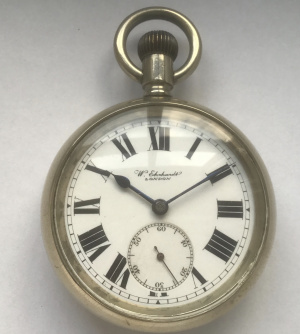
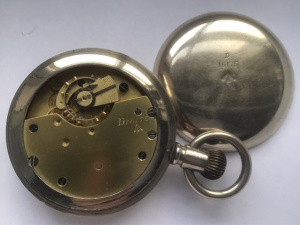

Two different types of movement were used in W Ehrhardt G.S. watches:
- a 7 jewel gilt ¾ plate English lever type movement of standard design (also used in the H White and H Williamson GS watches)
- a 7 jewel full plate pin-set movement where the balance wheel sits above a full plate and has an extended Bosley type regulator (matching the type used in the larger Elgin GS, although the latter is stem set)
Both watches use the same case, despite the extra clearance needed for the Bosley design. (Compare with the Elgin).
ZMW [p 21] ascribes the full plate movement to Ehrhardt’s own unusual design, and speculates that it may have been intended to protect the internal components. (It has also been described by others as incorporating a ‘quick release balance wheel allowing for swift repairs to be made in the field‘). However, the full plate design was long established in English watchmaking, harking back to the first fusée verge movements (although the GS movements are not fusée driven). By WWI, full plate had largely given way to ¾ plate movements that made for thinner watches and were easier to maintain (as ZMW also notes). The Ehrhardt G.S. watches that were pin set and featured the extended regulator design might have been intended to allow for greater precision in the setting (and security once set).
Although the dial reads W Ehrhardt, London, the company manufactured its watches (adopting machine methods in part) in Hockley, Birmingham. The fact that the London office was opened in 1898 leads some to date the W Ehrhardt watch to the Boer War period but the evidence for this is otherwise absent. It is much more likely that all three main examples of the GS watch were produced for issue during the 1914-18 war.
W Ehrhardt entered various chronometers for consideration in time trials conducted at the Royal Observatory, Greenwich, for the benefit of the Board of Admiralty, and produced many that were issued to the Royal Navy as chronometers or deck watches. (Ehrhardt naval issue watches show the movement serial number painted to the dial in the place where the issue number sits in GS watches supplied by other makers). The company also produced an 8-day version of the Mark IVA aviation watch, using a Swiss 8-day movement.
H White & Co Ltd, 63 Cheapside, London E.C. (vocab letter E)
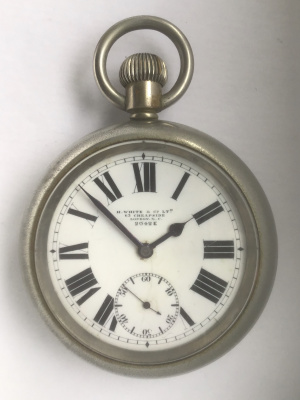
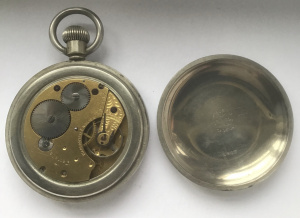
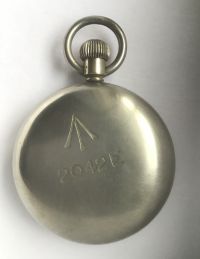
The H White watches employed a 7-jewel gilt ¾ plate English lever type movement of standard design that was used also in the Ehrhardt and Williamson G.S. watches.
The H White watches are only seen with 4-figure issue numbers and are the lesser spotted of the G.S. watches, implying that they were supplied in smaller numbers.
As with the H Williamson issue, Dennison nickel cases were used.
H White & Co Ltd is not a very well known company today but it entered watches in time trials conducted for the benefit of the Board of Admiralty. It also produced ‘The Admiralty Lever’ model wristlet for the civilian market, c 1914.
H Williamson Ltd, London (vocab letter F)
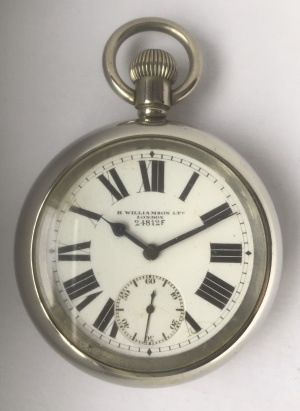
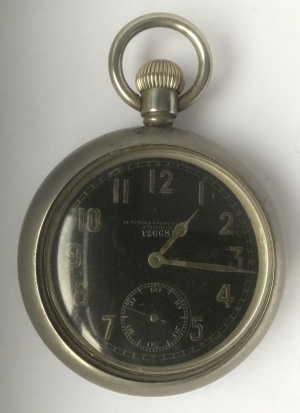
The H Williamson watches used the 7-jewel gilt ¾ plate English lever type movement of standard design that was also used in the W Ehrhardt and H White G.S. watches.
The H Williamson G.S. watches appear in two dial variations:
- white enamel with Roman numerals
- matt black painted brass with luminous arabic numbers to the dial and hands carrying luminous material in specially-shaped channels
The luminous watches might have been required for Royal Artillery use before the watches R.A. Standard was introduced in 1918.
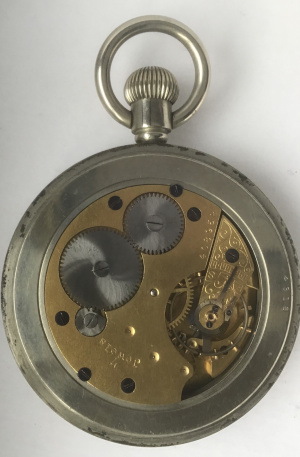
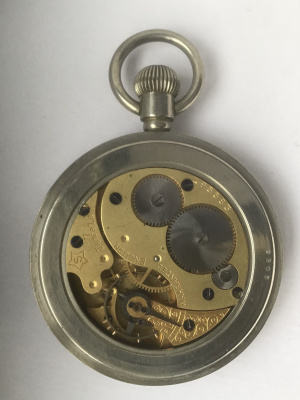
The H Williamson GS watch movement has two variants:
- a standard Lépine arrangement
- a Savonnette (hunter) arrangement, with the subsidiary seconds dial located at the 3 o'clock station

Many of the supplied savonette movements carry Williamson's Coventry Astral Star trademark (which dates from c 1910). The Astral was Williamson's standard 7-jewel model and was produced using machine made techniques. ZMW [p 26] describes the hunter movement as being used in Williamson’s earlier contract watches, culled from their existing stocks due to the exigencies of war. However, the watch shown in ZMW has a c 1916 issue number that probably reflects the supply crisis of the mid-war period rather than the rush to war in 1914. The two types of movement have entirely-separate serial number sequences applied to their plates, which run continuously in parallel throughout the issue.
H. Williamson used nickel Cases from Dennison but also employed an American made case (the Illinois Watch Case Co).
H. Williamson also supplied these 7-jewel watches as naval issue, with the movement serial number painted to the dial (where the issue number sits in the Army issue), and the backs being marked P ^ W. On the evidence of the Report of the Astronomer Royal relating to Chronometers (May 1915 to May 1916), these appear to date from 1915/16: ‘[a] cheaper form of watch, which has been given the name of Pocket Watch, was called for by the Admiralty during the year. Of these 600 have been purchased after being tested’. Further purchases were recorded for the duration of WWI: 200 watches (1916-17); 280 watches (1917-18); 396 watches (1918-19).
The pocket watches made by H Williamson Ltd were mostly machine-made in Coventry, with other factories operating in Birmingham and Chaux-de-Fonds (Buren). The Head Office and a branch works, however, were established in London E.C.1. The company also produced an 8-day version of the Mark IVA aviation watch using a Swiss movement that was sourced from Eterna.
Elgin (vocab letters R (G-294) and S (G-293))
The Elgin G.S. watch was supplied using two standard calibres (the Grade-293 and Grade-294), with the vocabulary letter and issue numbers tightly segregated between them.
Grade 293
The Elgin Grade 293 is a US 16 size, gilt, 7-jewel movement, of which 704, 000 were made in total between 1903 and 1927 in 257 runs. All British Army issued G-293s were produced from a run in 1916/1917.
The case is small and slim and comes with either a tapered stem with integrated bow ring or a plainer straight stem with bow.
All Elgin G.S. watches of this type carry issue numbers suffixed with the vocab letter S.
Grade 294
The Elgin Grade 294 is a US 18 size, 7 jewel full plate movement where the balance wheel sits above the plate and has an extended Bosley type regulator (matching the type used in one of the Ehrhardt GS watches).
In total, Elgin produced 446, 200 movements of this grade between 1903 and 1921 in 211 runs. The British-issued watches all use movements that were made c 1916/1917.
All Elgin G.S. watches of this type carry issue numbers suffixed with the vocab letter R.
General Points
The G-294 watch is thicker than the G-293, so its case has to be substantially larger in both width and depth (to allow for it being size 18 too). The case is notably large and robust.
All three Elgin watches use Silverode cases made by the Philadelphia Watch Case Co, numbered to all three parts. The Grade 294 is seen also in Keystone (Silveroid) cases.
Because these watches were made for export, ‘Elgin U.S.A.’ appears to the dial. There is conjecture that Elgin was contracted to supply the U.S. military with watches in WWI (Elgin advertising of the time certainly makes that connection), but the watches were possibly delivered late in 1918 and without any Government markings.
Unidentified watches (vocab letter Q)
Vocabulary letter 'Q' was possibly reserved for 'miscellaneous' (probably US made) movements of different design, usually nickel plated.
Royal Artillery Watch, R.A.
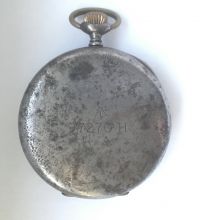
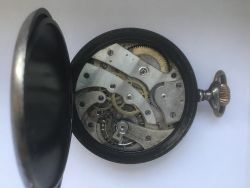
The G.S. standard is quite separate from the Royal Artillery Watch, R.A. (circa 1918), which was required to be fully luminous, with Swiss movements. Some hacked.
Some examples (such as the Paul Ditsheim watch pictured) have an R. A. mark applied quite roughly to the outer case under neatly engraved issue markings.
British Watches, Wristlet
The starting point
Some trench watches bear the unmistakable signs of issue to the British Armed Forces: a broad arrow marking and/or an engraved alphanumeric sequence (an ‘issue number’). Genuine examples of these watches are rare, and reliable information about them scarce.
The starting point for most discussions of WWI British military-issued wristlets is ZMW [p 60]. This short but troublesome text states that:
- the British War Department obtained wristlets c 1917 for evaluation and issue (hence some collectors know these as
1917 evaluation watches
); - the watch dials used were black enamel with radium-filled numerals and hands;
- a number of different unsigned Swiss lever 15 jewel movements were employed;
- two designs of case were used: snapback and screw back;
- the snapback watches proved unsuitable in the field and were disposed of, whereas the screw back watches proved themselves and were retained.
- the British War Department obtained wristlets c 1917 for evaluation and issue (hence some collectors know these as
Although I would challenge the first and last of these statements, a neat scheme is suggested whereby issued wristlets can be categorised according to whether their cases were of a snapback or screw back design, viz.
- the 38mm snap back;
- the various Dennison cased screw-back watches (3 distinct types).
